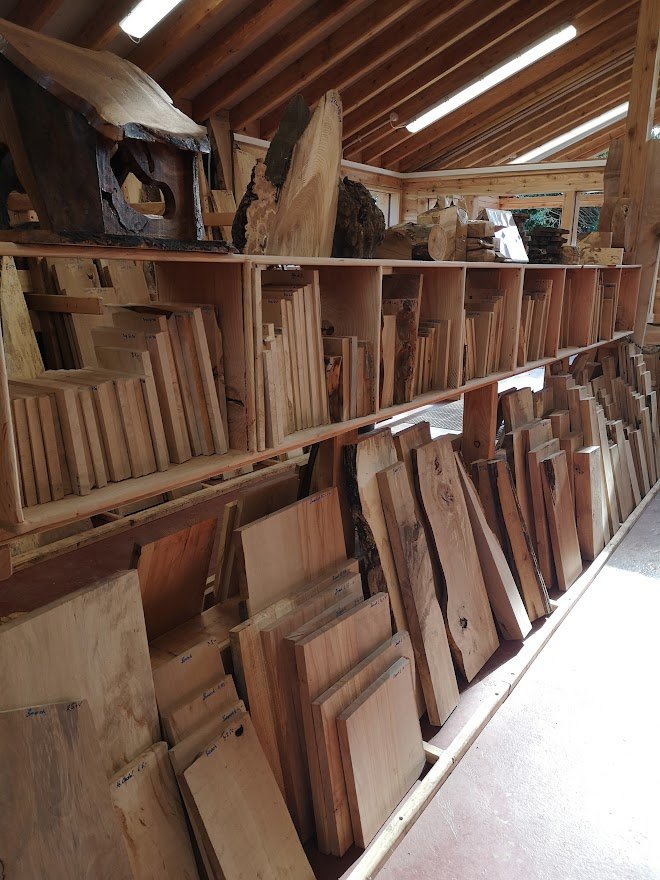Selecting Wood For Bowls
The art of selecting wood for bowls is both fascinating and complex.
Different woods not only bring unique aesthetic qualities but also possess characteristics that can influence their use and longevity.
Understanding Hardwoods and Softwoods
When choosing wood for bowls or any woodturning projects, it's crucial to understand the difference between hardwoods and softwoods. This distinction greatly influences the functionality, aesthetics, and longevity of the finished product.
Hardwoods
Hardwoods come from deciduous trees, which are trees that lose their leaves annually. Examples include cherry, walnut, and oak.
These woods are generally denser, making them more durable and resistant to wear and tear. This density also means hardwoods are often heavier and can be more challenging to work with.
However, this density contributes to the longevity and sturdiness of the final product.
Hardwoods are known for their rich and varied grain patterns, which add to their aesthetic appeal.
They are often chosen for high-quality, long-lasting items like furniture, flooring, and, of course, bowls.
When it comes to bowl-making, hardwoods are preferred for their durability and the beautiful finish they can provide.
Softwoods
Softwoods come from coniferous trees, which typically have needles and cones. Examples include pine, cedar, and fir.
These woods are lighter in density compared to hardwoods. Despite their apparent softness, this can often be an issue. Unless tools are razor sharp, they tend to tear out softwoods.
This lighter density can also mean they are less durable and more prone to damage.
Softwoods are often chosen for projects where the weight of the wood is a factor, or where easy cost is essential, such as in beginner woodworking projects.
As a rule of thumb, they tend to have a more uniform and less pronounced grain pattern than hardwoods.
Key Differences
Density: Hardwoods are denser than softwoods. This means they're typically more durable but also heavier and sometimes harder to work with.
Durability: Due to their density, hardwoods are generally more durable and long-lasting than softwoods.
Grain Pattern: Hardwoods often have a more varied and pronounced grain pattern, adding to their aesthetic appeal.
Cost: Generally, hardwoods are more expensive than softwoods due to their durability and the longer growth cycle of hardwood trees.
Usage: Hardwoods are often used in high-quality furniture and items that require durability, while softwoods are used in construction, beginner woodworking projects, and items where weight is a concern.
Cherry: Richness and Rarity
Cherry wood bowls are more than just kitchenware; they are often considered pieces of art.
The deep red hue and strong, dense nature of cherry wood give it a distinctive elegance.
Although more expensive due to its rarity, cherry wood's aesthetic appeal makes it worth the investment.
Cherry wood bowls can be quite the centrepiece in any setting, blending utility with sophisticated beauty.
Walnut: Unique Grain Patterns
Walnut wood is celebrated for its rich, dark tones and durability.
The unique grain pattern of walnut wood ensures that no two bowls are exactly alike, offering a unique addition to any collection.
It's also practical for everyday use, being strong and resistant to scratches and wear.
The non-porous nature of walnut wood makes it an excellent choice for serving food, as it won't absorb stains or odours easily.
Oak: Robust with Character
Oak is not just strong and durable; it's also characterised by its rich grain pattern, making each oak bowl unique.
This wood is suitable for both everyday use and as a display piece, offering versatility in its application.
Oak's strength ensures that it can endure daily wear and tear, making it a practical and long-lasting choice for any household.
Beech: The Understated Elegance
Beech wood, with its light colour and fine grain, is an attractive option for those who prefer subtlety.
It's easy to achieve a nice finish with beech wood, and its ability to take detail well makes it ideal for more intricate designs.
Beech wood bowls can add a touch of understated elegance to any setting.
Ash Bowls: Beauty of Strength and Flexibility
Ash wood, renowned for its strength and elasticity, is an excellent choice for crafting bowls.
It's a hardwood, but it's unique in the sense that it combines durability with a certain lightness and flexibility, making it an excellent hardwood for multiple purposes.
Their unique grain patterns, coupled with the wood's natural properties, make them a valuable addition to any kitchenware collection.
Softwoods: Pine and Cedar
For those looking for more affordable options, softwoods like pine and cedar offer a solution.
Pine is strong and easy to work with, making it an ideal choice for beginners or for those on a budget.
Cedar, known for its aromatic properties, adds a different dimension to bowl-making, bringing not just visual beauty but also a sensory experience.
Sustainability and Sourcing
In today's environmentally conscious world, the sustainability of the wood used for bowls is an important consideration.
Sourcing wood from sustainably managed forests is not only an environmentally responsible choice but also ensures the longevity and quality of the wood.
Two places I like to buy my wood from include Scottish Wood in Fife and The Wood Place in South Lanarkshire. Both with excellent practices when it comes to the milling or sustainable timber.
When selecting wood, it's beneficial to consider its origins and the practices involved in its harvesting.
Wooden Bowls
The choice of wood for bowls is a reflection of personal taste, functionality needs, and environmental considerations.
Whether you choose cherry for its elegance, walnut for its unique patterns, oak for its strength, beech for its subtlety, or softwoods for affordability, each type of wood brings its unique charm to your tableware.
Understanding the properties and origins of these woods can enhance your appreciation of these functional art pieces. And, help you make an informed choice that aligns with your values and needs.


